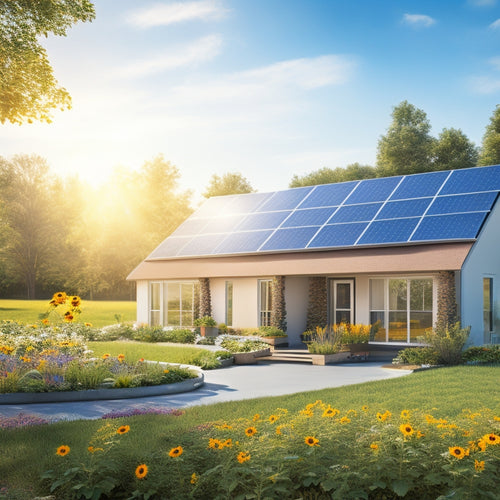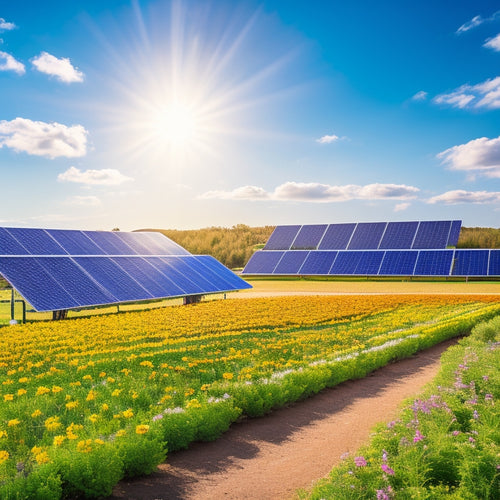
10 Steps to Get the Best Solar Panels for Your Home
Share
You're about to make a significant investment in solar panels for your home, and getting it right requires a thorough understanding of your energy needs, roof condition, and the technology itself. First, assess your daily energy usage and identify areas for improvement. Next, evaluate your roof's condition, considering age, shading, and material. Then, choose the right panel type, balancing efficiency, cost, and warranty. Research brands, exploring reputation, efficiency, and financial incentives. Get quotes from multiple installers, reviewing details and warranties. Finally, inspect and test the panels, ensuring proper installation and maintenance. By following these 10 steps, you'll be well on your way to making an informed decision that meets your unique needs and sets you up for long-term energy savings.
Key Takeaways
- Assess your energy needs by evaluating past utility bills and identifying energy-intensive appliances to choose the right solar panel system.
- Ensure your roof is suitable for solar panels by evaluating its age, material, and shading, and plan for roof replacement if necessary.
- Select the right solar panel type by considering efficiency, warranty, and cost, and researching reputable brands and manufacturers.
- Explore financial incentives such as local rebates, state tax credits, and utility rebate programs to reduce upfront installation costs.
- Evaluate installer credentials by checking their experience, certification, and insurance coverage to ensure a high-quality installation.
Determine Your Energy Needs
Your energy needs are a critical factor in determining the size and type of solar panel system that's right for your home. To get it right, you'll need to assess your energy consumption patterns. Start by reviewing your past utility bills to understand your average daily energy usage in kilowatt-hours (kWh).
Consider your energy-intensive appliances, lighting, and heating or cooling systems. This will give you a clear illustration of your energy demands.
Next, think about your future expansion plans. Are you planning to add more family members, install a hot tub, or invest in energy-hungry gadgets? Factor these potential increases in energy consumption into your calculations.
You'll want a solar panel system that can accommodate your growing energy needs.
Accurately determining your energy needs will help you choose a system that's neither too small nor too large for your requirements. This guarantees you maximize your energy savings and minimize your reliance on the grid.
Assess Your Roof's Condition
You'll want to evaluate your roof's condition before installing solar panels, as its age and shading can greatly impact the system's performance.
A newer roof with a long lifespan is ideal, as it won't need replacement during the solar panels' 25-year warranty period.
You should also inspect your roof for shading from trees, buildings, or other obstructions, as this can reduce the system's energy output.
Roof Age Matters
A roof's lifespan plays a vital role in determining whether it's suitable for solar panel installation. As you evaluate going solar, you'll want to assess your roof's condition to guarantee it can support the added weight and lifespan of the solar panels.
If your roof is nearing the end of its lifespan, it may be wise to think about replacing it before installing solar panels. This is because solar panels can last up to 30 years or more, and you'll want your roof to last just as long.
The timing of your roof replacement is essential. Replacing your roof at the same time as installing solar panels can be costly and inefficient. Instead, contemplate replacing your roof a few years before installing solar panels to secure a solid foundation for your solar investment.
Additionally, the type of roof material you have can impact the installation process. For example, asphalt shingle roofs are generally easier to work with than metal or tile roofs.
Inspect for Shading
Its south-facing slopes and surrounding terrain can greatly impact the effectiveness of your solar panel system.
As you evaluate your roof's condition, it's important to inspect for shading, which can markedly reduce your system's energy output. A shading analysis is vital to determine the extent of shading on your roof.
When conducting a shading analysis, consider the following factors:
-
Tree coverage: Trees surrounding your home can cast shadows on your roof, especially during peak sun hours. Consider trimming or removing trees to minimize shading.
-
Neighboring structures: Adjacent buildings, chimneys, or skylights can also cast shadows on your roof. Take note of these obstructions when evaluating your roof's sunlight exposure.
-
Roof features: Features like vents, skylights, and dormers can create shadows on your roof, reducing the available space for solar panels.
Choose the Right Panel Type
Selecting the right solar panel type for your home can make all the difference in capturing the sun's energy efficiently and effectively.
You'll want to evaluate the panel's efficiency, which is measured by its ability to convert sunlight into electricity. Look for panels with high efficiency ratings, usually above 20%, to maximize your energy output.
Another key factor is the type of photovoltaic (PV) cells used. Monocrystalline silicon cells are the most efficient but also the most expensive.
Polycrystalline silicon cells offer a lower-cost alternative with slightly lower efficiency. Thin-film cells are the least efficient but also the most budget-friendly option.
When choosing a panel type, also reflect on the warranty options. Look for manufacturers that offer extensive warranties covering both the panel's performance and materials.
A 25-year warranty is standard, but some manufacturers may offer longer or more extensive warranties.
Research and Compare Brands
Three top-rated manufacturers dominate the solar panel market, each offering unique strengths and weaknesses.
When researching and comparing brands, you'll want to evaluate factors beyond just efficiency and price.
Look for a brand with a strong reputation, built on years of experience and customer satisfaction. You should also examine warranty options, as a thorough warranty can provide peace of mind and protect your investment.
Some key brand comparisons to make include:
-
Brand X: Known for their high-efficiency panels, but with a higher price point to match.
-
Brand Y: Offering a longer warranty period, but with slightly lower efficiency ratings.
-
Brand Z: Providing a balance between efficiency and price, but with limited customer support options.
Check Local Incentives and Rebates
You'll want to investigate the local incentives and rebates available to you, as they can greatly reduce the upfront cost of installing solar panels.
For instance, you may be eligible for state tax credits, which can provide a substantial credit against your state taxes.
Additionally, you should look into utility rebate programs, which offer cash incentives for installing solar panels.
State Tax Credits
By now, you've likely evaluated the federal tax credit for installing solar panels on your home, but don't overlook the additional benefits offered by your state.
State tax credits can greatly reduce the upfront cost of going solar. Each state has its own set of regulations and incentives, so it's crucial to research what's available in your area.
To determine your state's tax eligibility, you'll need to review the state regulations. Here are a few things to take into account:
-
State tax credit amount: Find out how much you can claim as a state tax credit. This varies by state, but it's typically a percentage of the total system cost.
-
Tax credit carryover: If you can't use the full tax credit in one year, check if your state allows you to carry it over to future years.
-
Property tax exemptions: Some states exempt solar panels from property tax assessments, which can save you money in the long run.
Remember to factor in these state-specific benefits when calculating the overall cost of your solar panel system.
Utility Rebate Programs
In addition to federal and state incentives, utility companies also offer rebates to homeowners who install solar panels, further reducing the upfront cost of going solar. These rebates can be substantial, with some utility companies offering up to $2 per watt of installed solar power. To take advantage of these rebates, you'll need to check with your local utility company to see what programs are available.
| Utility Company | Rebate Amount | Financing Options |
|---|---|---|
| Pacific Gas & Electric (PG&E) | $1.25/watt | Yes, 10-year loan |
| San Diego Gas & Electric (SDG&E) | $1.50/watt | No, but partners with lenders |
| Southern California Edison (SCE) | $1.75/watt | Yes, 12-year loan |
| Duke Energy | $1.00/watt | No, but offers solar warranties |
| Xcel Energy | $1.50/watt | Yes, 10-year loan |
When exploring utility rebate programs, be sure to also consider the financing options and solar warranties offered by each company. By combining these incentives, you can greatly reduce the upfront cost of going solar and start generating clean energy for your home.
Evaluate Installer Credentials
With solar panel installation becoming an increasingly popular choice for homeowners, it's crucial to confirm that the installer you hire has the necessary credentials to get the job done right.
You want to verify that the installer has the skills, knowledge, and experience to install your solar panel system correctly and efficiently.
When evaluating an installer's credentials, consider the following:
-
Installer experience: How many solar panel systems has the installer installed? Do they've experience with installations similar to yours (e.g., residential, commercial, or industrial)?
-
Certification programs: Is the installer certified by a reputable organization, such as the North American Board of Certified Energy Practitioners (NABCEP)? Are they up-to-date on the latest industry standards and best practices?
-
Manufacturer certifications: Is the installer certified by the manufacturer of the solar panels you're interested in? This guarantees they've the necessary knowledge to install the system correctly.
Get Quotes From Multiple Installers
Getting multiple quotes from different installers is an essential step in finding the best fit for your solar panel needs. This allows you to compare prices, services, and warranties from various companies, increasing your chances of getting the best deal.
When requesting quotes, verify you provide each installer with identical information about your energy requirements and roof specifications to guarantee accurate comparisons.
You should aim to get quotes from at least three to five installers with a good reputation in your area. Check online reviews, ratings, and testimonials to gauge their installer reputation.
Be wary of extremely low quotes, as they might indicate low-quality equipment or poor installation. Instead, focus on quotes that provide transparency on the equipment used, installation process, and maintenance costs. A transparent quote will give you a clear understanding of what you're getting for your money.
Review and Compare Quote Details
You've gathered quotes from multiple installers, and now it's time to scrutinize the details. This is a vital step in the process, as it's where you'll identify the best value for your money.
Take a close look at each quote, paying attention to the equipment, installation, and maintenance costs.
Be sure to investigate the following aspects of each quote:
-
Cost transparency: Are all costs clearly outlined, or are there any hidden fees?
-
Equipment specifications: What type and quality of panels are being offered, and how do they compare across quotes?
-
Quote negotiation: Are there any opportunities to negotiate the price, and what kind of warranty or guarantee is being offered?
Inspect and Test the Panels
Your solar panel installation is nearing its final stages, and it's crucial to confirm the equipment is in top condition before it's integrated into your home's electrical system. Now's the time to inspect and test the panels to verify they meet the required standards.
Conduct a visual inspection of the panels to check for any signs of damage, such as cracks or broken glass. Verify that the panels are correctly labeled and that the electrical connections are secure.
You should also check the panel efficiency, which is typically specified on the manufacturer's datasheet. Compare the actual efficiency with the manufacturer's claims to ascertain it meets your expectations.
Test the panels to validate their electrical output. This involves measuring the voltage, current, and power output under various conditions. Make sure the test results match the manufacturer's specifications.
Additionally, review the warranty options provided by the manufacturer and installer. Understand the terms and conditions, including the duration, coverage, and process for filing claims.
Ensure Proper Installation and Maintenance
You'll want to guarantee your solar panels are installed and maintained correctly to maximize their energy output.
This involves optimizing the panel angle and tilt to capture sunlight, establishing regular cleaning schedules to remove debris, and performing electrical connection checks to prevent energy loss.
Panel Angle and Tilt
Optimizing panel angle and tilt is vital for guaranteeing the maximum energy output of your solar panels. You want to get the most out of your investment, and proper installation is significant. The best orientation of your solar panels depends on your location and the time of year.
To maximize energy production, consider the following:
-
Seasonal adjustments: Adjust your panel angle to account for the changing sun's position throughout the year. This guarantees you're capturing the most sunlight possible during peak hours.
-
Latitude and longitude: Consider your location's latitude and longitude to determine the ideal tilt and angle for your solar panels.
-
Shading and obstacles: Take into account any shading or obstacles that might affect your solar panels' performance, such as trees, buildings, or chimneys.
Regular Cleaning Schedules
Efficiency hinges on more than just installation; it also relies on consistent upkeep. To get the most out of your solar panels, you'll need to establish a regular cleaning schedule. A dirty panel can lose up to 25% of its efficiency, so it's essential to clean them frequently.
The cleaning frequency will depend on your location and environmental factors, such as proximity to highways or dust-prone areas. As a general rule, you should clean your solar panels every 6-12 months.
When it comes to cleaning techniques, you'll want to use a soft-bristled brush or a specialized solar panel cleaning tool to remove debris. Avoid using harsh chemicals or abrasive materials that can scratch the panels.
Instead, use a mixture of mild soap and water to gently clean the surface. For more stubborn grime, you can use a pressure washer on a low setting.
Electrical Connection Checks
Regular cleaning is just one aspect of maintaining your solar panels' performance; another critical component is ensuring the electrical connections are secure and functioning properly.
You'll want to inspect the wiring and connections regularly to prevent electrical shocks, fires, and system malfunctions.
Verify that all electrical connections meet local wiring standards and safety regulations.
Check for:
- Loose or corroded connections, which can cause electrical arcing and fires
- Damaged or frayed wiring, which can lead to electrical shocks and system failures
- Proper labeling and signage, ensuring easy identification of electrical components and emergency shut-off points
Frequently Asked Questions
Can I Install Solar Panels Myself to Save Money?
You can attempt a DIY installation to save money, but it's essential to weigh the cost savings against potential risks, such as voiding warranties, compromising system efficiency, and ensuring compliance with local building codes and permits.
How Do I Know if My Homeowners' Association Allows Solar Panels?
You think you've got the perfect spot for solar panels, but don't get blinded by the sunshine - check your HOA regulations first, as they may have strict rules or require special permits, crushing your eco-friendly dreams.
Will Solar Panels Increase My Home's Property Value?
You'll be pleased to know that installing solar panels can increase your home's property value, as a property appraisal will likely reflect the added value, making solar panel financing a worthwhile investment in your home's future.
Can I Use Solar Panels to Charge My Electric Vehicle?
You can use solar panels to charge your electric vehicle, leveraging solar charging to maximize EV efficiency; with a compatible system, you'll utilize renewable energy to power your daily commute, reducing your carbon footprint and energy costs.
Are Solar Panels Resistant to Extreme Weather Conditions?
You'll be relieved to know that solar panels are designed to withstand extreme weather conditions, with manufacturers testing their products to guarantee durability against hail, wind, and snow, minimizing the weather impact on your renewable energy source.
Conclusion
You've made it! You're now equipped to find the best solar panels for your home. Did you know that solar energy can save homeowners between $400 and $1,000 per year on their electricity bills? By following these 10 steps, you'll be on your way to utilizing the sun's power and reaping its financial benefits. Remember to stay informed, do your research, and don't settle for anything less than the best. Happy solar shopping!
Related Posts
-

Home Solar Systems for Environmental Impact
Home solar systems markedly reduce your carbon footprint by utilizing renewable energy. By adopting solar energy, you...
-

High-Performance Solar Solutions for Sustainable Living
High-performance solar solutions are your gateway to sustainable living, maximizing energy efficiency while considera...
-

Energy-Efficient Heating and Cooling Appliances
Energy-efficient heating and cooling appliances can cut your energy bills markedly. By opting for models with high En...


